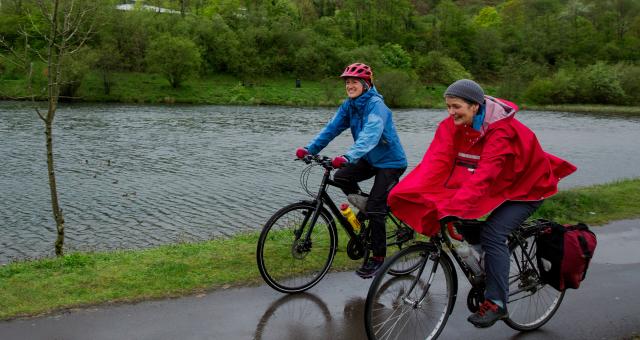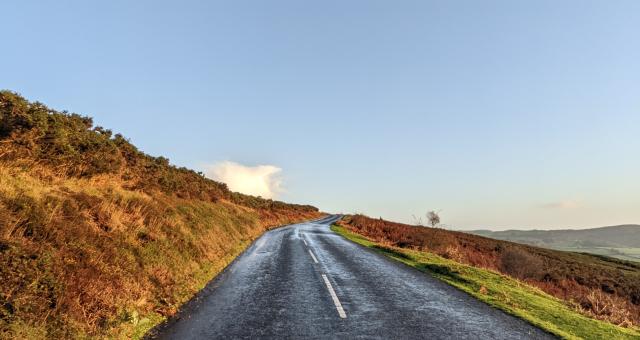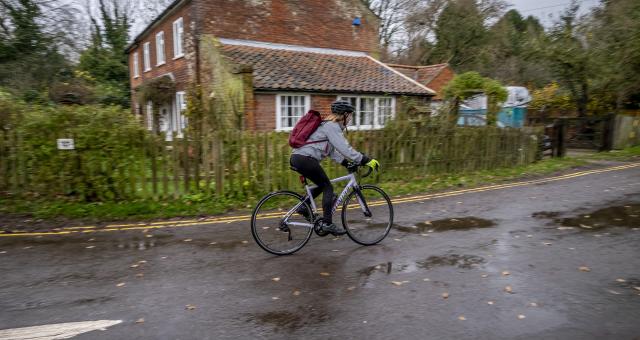How to get your bike ready for autumn cycling

Autumn is a wonderful time for cycling: misty mornings, the leaves turning red and gold, fewer people on the trails or cycle paths, a hot chocolate to warm your hands when you get home or at your favourite coffee stop.
But the colder, wetter weather, unpredictable conditions and shorter days pose their own challenges. Autumn-proof your bike with our advice and you’ll carry on cycling all through the season.
1. Light it up
First and foremost, you need lights. Even if you think you’ll only be riding during daylight hours, the shorter days mean you can easily be caught out. You never know when you might end up working late or a mechanical means that short ride took longer than planned.
In the UK it’s a legal requirement to have a white front light and red rear one between sunset and sunrise. You should also have front, rear and pedal reflectors. Read our guide on light regulations for more detailed information.
Retrieve your lights from wherever you’ve stored them over summer and check they’re working. Replace or recharge batteries as needed; if necessary replace the light set. It’s a good idea to have a cheaper spare set to get you home should your main lights fail.
2. Guard duty
If your bike doesn’t have them, fit mudguards. If the bike doesn’t have mounts for these – most road bikes don’t, for example – there are various options that attach to seatposts, down tubes and so on.
Mudguards prevent mud and water splattering all over you and your bike. This is particularly important if you ride to work in your work clothes – you don’t want to spend all day in a mud-covered suit! But even on a solo day ride, a wet, muddy bum isn’t the most pleasant experience.

Mud and water will also creep into the bike’s components, wearing them away and shortening the life of the bike. Mudguards will help prevent this.
It’s also more polite. You don’t just spray water all over yourself, but over riders behind you too. Most clubs won’t let you ride with them in winter unless you have full guards. If you commute regularly, you don’t want to be the menace at traffic lights covering fellow riders in filthy rainwater.
3. Tyred out
Autumn is likely to bring a lot more rain, slippery leaves on ground and more debris to contend with. It’s a good idea to swap out your tyres for wider ones with more tread. Check the pressure too. Slightly less will increase contact with the ground, giving you more grip.
Look for puncture-resistant ones. The autumn rain will wash debris into the sides of the road where you’re most likely to be riding. Standing next to the road in the rain and spray from cars while you fix a puncture is miserable, so try to avoid it where you can.
However, before you do anything, check your bike’s clearance. If you try to fit tyres that are too wide, they’ll rub, potentially damaging the tyres and your forks. If in any doubt, take your bike to your local bike shop and let the experts do it.
4. Basic maintenance
You’ve probably been making the most of the summer and riding more, whether that’s to the shops, work or long club rides – or all the above! This will have increased wear and tear on your bike, and autumn’s cold and wet conditions will put extra strain on it.
Ensure you’re heading into autumn with your bike in tip top condition by performing some basic maintenance checks. This will also reduce the risk of a mechanical on a ride, saving you from having to fix it in less-than-ideal conditions.
The main components to check are brakes, gears and drivechain (that is, chain, chainrings and cassette). To check the brakes, simply spin the wheel and pull on the brake lever. The pads should bring the wheel to a stop smoothly and quickly. The lever itself shouldn’t come too close to the handlebar. Otherwise, you need to adjust the brake cables or pads.

On a ride, cycle through all your gears, checking that the chain moves between the cogs smoothly and silently. If the chain moves too quickly or with a delay, or there’s a crunching sound, you’ll need to adjust the derailleurs.
At the same time, ensure the whole drivechain is clean and working well. For more advice on maintaining your bike and how to adjust brakes and gears, read our simple tips to keep your bike in peak condition.
5. Get the right lubricant and use it
Your drivechain will suffer more as autumn progresses, with rain, mud and debris all conspiring to clog up the chain, chain rings and cassette. Get it ready by giving the whole drive chain a thorough clean; using a dedicated chain degreaser will make this a lot easier, but good old soap and water will do the trick.
Once it’s all dried out, lubricate the chain properly. A drop on each chain link is ideal. Invest in a good lube designed for cycles. You’ll need a wet lube – this will be water resistant and so last longer in the autumn weather, and also less ‘sticky’ than a summer dry lube, which will only attract dirt and debris to your chain, where it’ll cause all kinds of damage.
A squirt of lube down your gear and brake cables will also help keep them moving freely and improve your ability to shift or stop.
Remember to clean and lube the drivechain throughout the season to ensure its runs smoothly and protect it against the elements.
6. Keep it clean
Now that you’ve performed your basic maintenance and got the chain lubricated, it’s time to give the rest of the bike a good clean.
Keeping your bike clean really is one of the best ways to keep it in the best condition – it’s easy too, and if you do it often it won’t take long. Read our beginners’ guide to cleaning your bike for the full rundown of how to do it.
7. Check your toolkit
No matter how well you look after your bike, mechanical issues can occur, and the last thing you want in autumn is to be stranded on the road or trailside waiting for help.
Even with the most puncture resistant of tyres, punctures are the most common problem, especially for commuters. So at least ensure your toolkit contains a spare innertube or two, tyre levers, mini-pump and multitool.

This should be enough to fix most problems that might occur, at least long enough to get you to your destination. Any further work can then be carried out somewhere better lit and hopefully warmer and dryer.
For longer and off-road rides, you might need a more comprehensive toolkit. Work out what you need for each ride and keep it handy. Make sure it’s all in working order. Look after your tools and they’ll look after you – or your bike.
8. Invest in waterproof luggage
Most bike bags, from panniers to bar bags, are water resistant, keeping your kit dry in light summer rains. But come autumn, with its heavy downpours, these won’t keep the water out.
You can get waterproof linings to put your belongings in. This is often a cheaper option but can be a bit of a faff. Investing in waterproof bags will give you peace of mind and likely keep your things drier. Cycling UK members can benefit from savings with a variety of retailers such as Halfords, Decathlon and Carradice, so new kit doesn’t have to break the bank.
This is particularly important if you ride to work and need to transport electrical equipment like your laptop. No one wants to have to explain to the IT department that their computer isn’t working because it got drenched on the way to work.
There’s no need to stop cycling just because the leaves are turning – your bike is now set to carry you through autumn and into winter. Remember, winter miles make for summer smiles!




